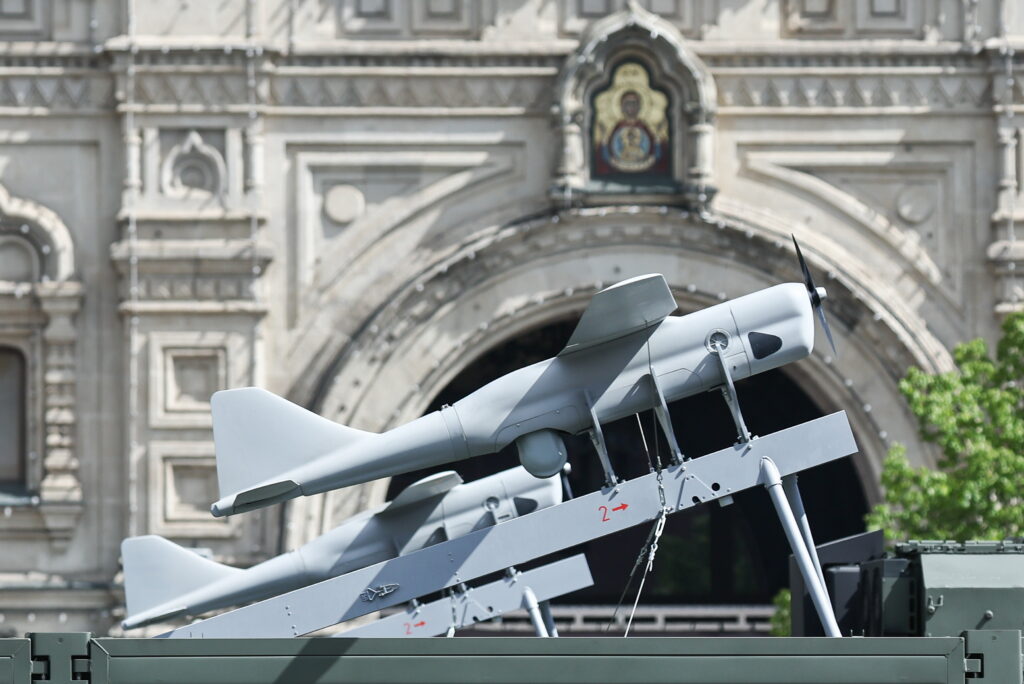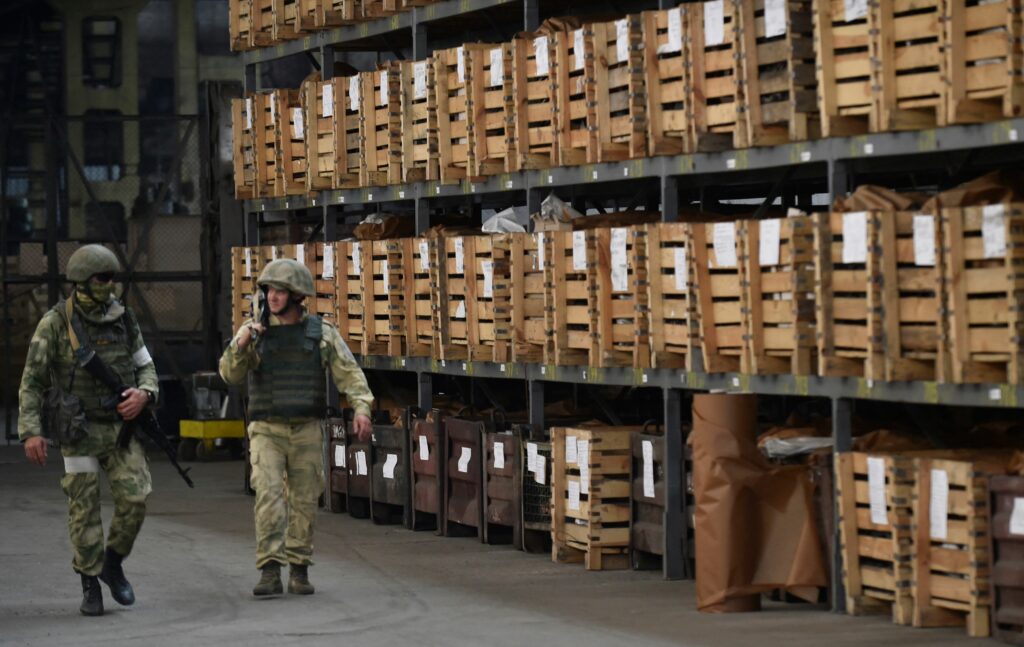In a regular interview to a government-controlled TV channel, Vladimir Putin announced that starting from April 2023, pilots of the Belarusian Air Force would start training to learn how to use Russian tactical nuclear weapons from 10 aircraft specially equipped for this purpose (presumably Su‑30SMs). He also stated that a storage facility for such weapons in Belarus would be completed by 1 July 2023 and that the Iskander operational-tactical missile complexes had been transferred to Minsk with the nuclear option retained.
Moreover, the Kremlin officially announced its intention to mimic the American approach, whereby U.S. airbases in Belgium, Germany, Italy, the Netherlands and Turkey are used to host gravity nuclear bombs which pilots from these countries together with the Americans could operate in the event of a major war, upon a relevant political decision. Incidentally, this differs from the Soviet approach towards the deployment of nuclear weapons in the Warsaw Pact countries: the USSR ruled out the very idea to get those countries involved in potential use of such weapons. However, claims that Russia is now doing what the United States has been doing for decades are only masking Moscow’s real intentions, as well as the inevitable consequences of this move.
Surrounding Lukashenka on his pitch
Generally, the deployment of Russian tactical nuclear weapons in Belarus emerged back in 2021, at Lukashenka’s behest. One cannot tell for sure if this was entirely his initiative or not, and to what extent such foreign policy game was coordinated with Moscow, but the rhetoric did matter to Minsk. Largely isolated from Europe and, more broadly, the West after the 2020 events, the Belarusian leaders were trying everything to score some points. Belarus was going to sell an artificial problem of regional security to European politicians, offering a very real solution, helping Belarus to break its international isolation at least to some extent.
The Kremlin’s interest in this matter was also evident. At the time, Moscow was already preparing for the infamous NATO ultimatum and aggression against Ukraine. The ‘bargaining’ about the possible deployment of nuclear weapons in Belarus could have been seen as an additional pressure on the West, incentivising it to revise the essential rules of European security, as well as post-Cold War international relations at large. However, once again, one cannot be sure whether this idea was the Belarusian dictator’s personal initiative or not.
The ‘bargaining’ started to yield some results for Minsk only after 24 February 2022, when French President Macron spoke to Lukashenka by phone on the third day of the war. One of the major topics discussed was the prospect of Russia’s tactical nuclear weapons being deployed in Belarus. At the same time, the military, political, economic and moral disaster initiated from the very first day of the war and deteriorating ever since, also gave a very grim prospect for the Belarusian authorities. The room for preserving at least some remnants of political autonomy were rapidly shrinking (also in international affairs) given the significant number of Russian troops stationing on the Belarusian territory. However, if Minsk was going to retain any freedom of manoeuvre in its hands, this would turn into an increasing problem for Moscow, which itself was sinking even deeper.
As a result, the decision to deploy tactical nuclear weapons in Belarus could not be made later than July 2022. Importantly, the adaptation of 10 Belarusian aircraft (apparently, Su-30SM) to carry nuclear weapons and the construction of a storage facility need time, whereas the decision to transfer Iskander to Minsk was made as early as June 2022. As a consequence, Lukashenka was simply deprived of an important bargaining chip in talks with the West, since the deployment of tactical nuclear weapons had turned from a threat into an open process. At present, the non-participation of the Belarusian army in the war against Ukraine is the only sign of the Belarusian leader’s autonomy versus the Kremlin.
The announced deployment of tactical nuclear weapons also means that Russia is inevitably turning its extensive but formally temporary military presence in Belarus into a permanent one. The issue at stake is a special repair-and-maintenance facility where a small group of officers is tasked with maintaining a very limited number of nuclear warheads/bombs that are brought from a central storage base in Russia and assigned to aircraft and missile systems. Certainly, such a weapon storage facility would need a security commando and a vehicle depot. However, such a facility cannot be placed on the territory of another country on its own as this would contradict all Russian planning in this sphere. The rule is that Russian nuclear weapons must always be safe and under Moscow’s full control whereas a security commando (or even a security battalion, customarily employed at central storage facilities) is not sufficient for this purpose.
All this means that Russia’s permanent military presence in Belarus is an issue that must be resolved before the first tactical nuclear warhead or airbomb arrives in that country. Perhaps that is why Lukashenka took a pause and was in no hurry to comment on the Kremlin’s decision at the time of writing this article, as the decision was announced on TV rather than during a bilateral meeting, for instance.
A negative signal for China
Interestingly, the plans to deploy tactical nuclear weapons in Belarus were disseminated just a few days after Xi Jinping’s official visit to Russia. The joint statement following that visit includes the following claim: «No nuclear powers should deploy nuclear weapons outside their countries’ territories and should withdraw all nuclear weapons deployed abroad.» Such a blatant disregard for basic diplomatic etiquette indicates two things.
On the one hand, Moscow’s capability of adhering to international rules, and even to its own declared political principles, clearly continues to diminish. On the other hand, if Moscow meant to behave like this, one could presume that it has little or no other political way to demonstrate its confidence and strength to the world.
In this way, unpredictability replaces real power. However, unpredictability must be constantly fuelled. A regular country is unlikely to behave like this for a long time because contradictions will inevitably accumulate, both in foreign policy and at the level of state institutions. The latter is important because it makes no practical sense for Russia to keep its tactical nuclear weapons in Belarus. In fact, such a step additionally increases the organisational and technical costs involved. Furthermore, Russia’s demarche with the tactical nuclear weapons clearly undermines its own attempts, even if not very successful, to squeeze substantial economic benefits from Xi Jinping’s official visit.
The issue with the Non-Proliferation Treaty and Missile Technology Control Regime
Non-proliferation of nuclear weapons and missile technology is another important aspect of the story. Formally speaking, Moscow’s plan to deploy tactical nuclear weapons on the Belarusian territory is indeed not in violation of the Treaty on the Non-Proliferation of Nuclear Weapons (NPT) since, as Moscow clearly emphasises, nuclear weapons are not transferred to anyone. However, in such cases, it is always important to consider the context in addition to formal aspects.
For example, the United States has deployed nuclear weapons on its bases in a number of NATO countries for possible joint use in the event of war. This process started in the second half of the 1950s, i.e. before the NPT was signed (which happened in 1968). One exception was Greece, where U.S. nuclear weapons were deployed from 1978 to 2001. However, this happened in the context of negotiations and agreements between the Soviet Union and the United States, focused on non-proliferation and then reduction of nuclear arms, as well as the reduction of the number of military nuclear programmes carried out by various countries. Simply speaking, the NPT generally worked well, and its parties had higher priorities than U.S. nuclear bombs in NATO member states. Likewise, Soviet nuclear weapons in a number of Warsaw Pact countries were not a pressing issue, either.
Moreover, with the end of the Cold War, Soviet nuclear weapons were withdrawn from Eastern Europe, and after the collapse of the USSR ⸺ also from Belarus, Kazakhstan and Ukraine. The USA also began reducing its nuclear arsenal deployed in NATO countries and its storage bases there. Today, approximately 100 nuclear bombs are located in six American air bases in Belgium, Germany, Italy, the Netherlands and Turkey as part of American security guarantees to its allies. After yielding solid results in the first four decades, the implementation of the NPT began to stall in the 2010s. This was connected with the nuclear programmes undertaken by North Korea and Iran, as well as Russia’s annexation of Crimea and its war against Ukraine, first waged in the so-called ‘hybrid’ format between the spring of 2014 and 24 February 2022. The invasion happened in violation of Russia’s guarantees for the security and inviolability of Ukraine’s borders that were given in the 1990s in exchange for Ukraine’s surrender of its nuclear weapons from the Soviet times.
In other words, Russia itself dealt a heavy blow to the NPT in 2014. The following events happened afterwards: the dismantling of the Intermediate-Range Nuclear Forces Treaty (INF) in 2019, the U.S. and Russian withdrawal from the Treaty on Open Skies in 2020 and 2021 respectively, the suspension of inspections under the START Treaty from March 2020, leading to Russia’s complete suspension of its participation in the New START Treaty in February 2023. Moreover, we should not forget the resumption of military-technical cooperation between Russia and Iran in 2022, when the Iranian nuclear deal (Joint Comprehensive Plan of Action, JCPOA) was not re-launched after being suspended in 2019. In this context, the Kremlin’s plans to deploy tactical nuclear weapons in Belarus, although not violating the letter of the NPT, actually continue to dismantle the nuclear non-proliferation regime.
What deserves a separate mention is the transfer of the Iskander complexes to Belarus, announced in June 2022 and officially completed by February 2023. Apparently, Russia did not send the export version to Belarus, but, instead, it offered the complete version with a range of up to 500 km, able to carry a 500 kg warhead. Indeed, this violates another international regime that Russia had committed to observe, namely the Missile Technology Control Regime (MTCR). One of the main conditions of the MTCR provides for export restrictions on missile systems that can carry a 500+ kg warhead for 300+ km. Worth recalling is that Australia’s plans to purchase the BGM-109A Tomahawk cruise missiles from the United States in 2021 were criticised in the context of compliance with the MTCR, despite the fact that these missiles had a warhead that met the weight limit. It turns out that the Kremlin decided not to wait and resolved to undermine this regime as well.
Conclusion: Russia’s main motive
Having lost the ability to comply with existing international rules, Russia is working hard to finally destroy them, in addition to waging a war. In this regard, the plan to deploy tactical nuclear weapons in Belarus is intended not only to exert additional pressure on Kyiv and finally bind the Belarusian regime to Moscow, but also to drive another wedge into NATO to undercut its unity. The Kremlin hopes that at least some European members of the alliance will prove more receptive to its nuclear threats. In practice, however, this approach is likely to deteriorate Russia’s foreign policy positions even further.










